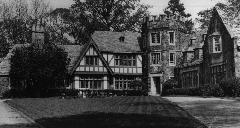
The wife of Emory University President William M. Chace and a senior lecturer in the English Department, JoAn Chace says her favorite aspect of Lullwater life is the way in which the home works together with its surroundings. "It's a wonderfully comfortable place, and that springs in large part from the marvelous integration of the grounds and the house," she says, sitting beside the fireplace in the mansion's living room. "Whenever you are in a room, you are looking out at the rolling hills, at the wonderful trees, and it gives you a sense of peace and pleasure. . . . In many rooms you can look out both sides. It's almost like a modern house with glass walls, because so much of the outdoors is brought in."
For President Chace, the environs at Lullwater are equally important. "I find Lullwater a fantasy, a place so beautiful and restful that I cannot really believe we have the good fortune to live here," he says. "One of the treasures of the place is having so many happy people thronging the park. Were it not for their constant company, the isolation would be odd and difficult. I am glad that Lullwater is, in most respects, public. . . . We are very happy that Lullwater, with its lake, its rolling hills, its lovely trees, its many birds, the occasional sight of its families of egrets, herons, ducks, and beavers, is here for one and all."
Since 1963, Lullwater has been home to the president of Emory University and his family. On August 23 of that year, Sanford S. Atwood, the University's sixteenth president, became the first to take up residence there. The home and the 185 acres of woods and fields that surround it were purchased from Emory alumnus and benefactor Walter T. Candler in 1958 for between $750,000 and $1 million.
At that time, then-President S. Walter Martin lived in a home at the corner of North Decatur and Clifton roads, on what is the current site of the School of Law. According to one source, Dr. Martin was uncomfortable about living at Lullwater because he felt his wife would be too isolated when he was out of town on business, and therefore he decided against moving. For part of the time between the purchase date and when the Atwoods moved in, the house was vacant, and for part of the time it was a makeshift dormitory for computer researchers who were working in conjunction with the School of Business.
Recently, Lullwater House underwent some major renovations. "The [work was] sparked by the need for heating and air conditioning," says JoAn Chace, who taught her second class of freshman English at Emory this fall. "The whole system was greatly antiquated. It was inefficient and unpredictable, and it required heavy maintenance. So the trustees determined to put in a new system. . . . Once that had been done and people began to look at the condition of the wood and the windows, it was decided to go forward with reconditioning the wood and restoring the windows, which were becoming corroded."
Even though the renovations meant the Chaces had to live off campus for several months when they arrived at Emory in August 1994, JoAn Chace believes the time and money put into the home were well spent. "Absolutely. It's an irreplaceable house," she says. "It's not just a grand house, it's an unusually elegant house with wonderful woodwork, plaster work, and tiled bathrooms. It's a perfect example of the 1920s eclectic Tudor style."
Construction began on Lullwater House in 1925 and was finished the following year. The home was designed by architect Lewis E. Crook and constructed by his business partner Ernest D. Ivey. According to a 1985 Emory Magazine article, "Ivey and Crook's success with Lullwater led to their being named unofficial architects for Emory. From the 1920s to the 1950s, Crook designed some forty buildings" on the Emory campus, including the Candler Library, the Alumni Memorial University Center (now part of the Dobbs University Center), and the Administration Building.
The fieldstone used to construct the 7,500-square-foot, L-shaped, Tudor-Gothic manor was quarried on the grounds. The home itself sits on a hill, approximately one hundred feet above an eleven-and-a-half-acre, man-made lake. The body of water was created when Walter Candler had a dam placed on South Peachtree Creek, which runs through the property. A granite powerhouse was built next to the dam, and for a number of years it was used to supply the home with electricity.
While the grounds surrounding Lullwater House have remained undeveloped, serving as a quiet oasis for countless members of the Emory community, the land was used much differently when the Candlers were in residence. The entire estate was known as Lullwater Farms during that time, and cattle grazed on the fields. Also, according to a November 1958 article in the Emory Alumnus, "Mr. Candler had an almost life-long interest in harness racing. . . . For many years he kept his horses at Lullwater Estates, where he also worked them out and put them through their practice races."
Even though horse riding is no longer a fixture at Lullwater, President Chace, an avid cyclist, can frequently be seen pedaling his two-wheeled steed out of Lullwater to his office. Most people who have been to the park are familiar with the long, winding hill that rises up to Clifton Road, but President Chace is philosophical about the climb. "The rise up to Clifton is not difficult for either pedestrians or for bikers," he says. "And keep in mind, as an ancient Greek, Herodotus, said, `the road up is the road down.' You pedal up, and you coast down."
Click here to return to Emory University Home Page.